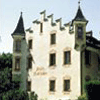|
|
|
Bressanone Guide Italy
|
|
|
|
 |
|
|
|
|
|
Directories of Web Sites:
Bressanone Italy
Bressanone Hotels
Bressanone Guide
Visitors soon receive a clear impression of Brixen's old town.
Since the Middle Ages, the heart of the town has had a character of a markedly dualised nature: in the north, in the business centres of Lauben, Graben and Altenmarkt and in Stufels to the east, the bourgeois character of Brixen predominates; moving south from the Domplatz, the spiritual side of the town is more in evidence. The hum of business in the north and contemplative peace in the south make an attractive contrast. A wall surrounds the heart of the town, and the town wall in the north with its perfectly straight line from east to west near the towers of the cathedral and parish church is still one of the most important features of the town today.
Every tour begins in the Domplatz, redeveloped in 1998, with the imposing façades of the cathedral and St Michaels parish church on the east side, the town hall on the north side and public buildings on the west side. Towards the southwest the square opens out on to the east side, the town hall on the north side and public buildings on the west side. Towards the southwest the square opens out on to the Hofburg, where the Diocesan Museum can be found. The interior of the om (cathedral), reworked in the Baroque style between 1745-1758, is a monumental experience. Its broad vaulted nave is richly decorated with marble and stucco, the high altar by Teodoro Benedetti includes an expressive altar print by Michelangelo Unterberger. The high point of the artistic work is the ceiling fresco, the "Adoration of the Lamb" by Paul Troger. Immediately to the south of the cathedral is the Kreuzgang (cloister), which represents the stylistic richness of form in the late Gothic style as found in the Tyrol. Excellent artists from the Brixen and Bruneck art schools painted 15 of the 20 archways in the ambulatory between about 1370 and 1510. The (usually closed) Johanneskapelle at the southwest of the cloister is a showpiece of early Romanesque painting.
From the cloister it is only a short distance to the Seminarplatz. The priests' seminary, reworked in the Baroque style circa 1750, today serves as the Theology College. Immediately to the south of this is the Cusanus-Akademie, a busy college. Behind the seminary is spread the panorama of the Brixen hinterland with the low mountain range St. AndrÉ, and the villages of St. Leonhard, St. AndrÉ, Mellaun and Klerant. Above the low mountain range stands the Plose (approx. 2500 m), Brixen's Hausberg. Just a short distance away in a northerly direction from the seminary, past the back of the cathedral and the parish church, is the Michaelstor. Turn right here and the roads will take you via AdlerbrÄckengasse and the AdlerbrÄcke to the attractive district of Stufels. If you go left the road goes via the Pfarrplatz with its prestigious "Pfaundlerhaus" directly to the shopping centre, Gro¤e and Kleine Lauben. The Lauben came into being at the beginning of the 1400s; the sheltered alleyways protected passers-by and inhabitants from the rain and the sun.
Moving in a southerly direction from here, the Kleine Lauben leads towards the "Hofburg", the residence and administrative headquarters of the bishop until 1964 and, since 1974, the Diocesan Museum. Surrounded by a moat, the Hofburg is simultaneously an architectural jewel and a treasure chamber: the inner courtyard with Renaissance archways directs you to the display rooms in the house. They contain sacred works of art from the Romanesque period to the modern era and the Kaisertrakt offers a glimpse of the sophisticated Rococo culture.
(Images and Contects given by the Tourist Office Brixen)
|
|
|
|
Acquista la tua visibilità su Travel Plan
|
|
|
|